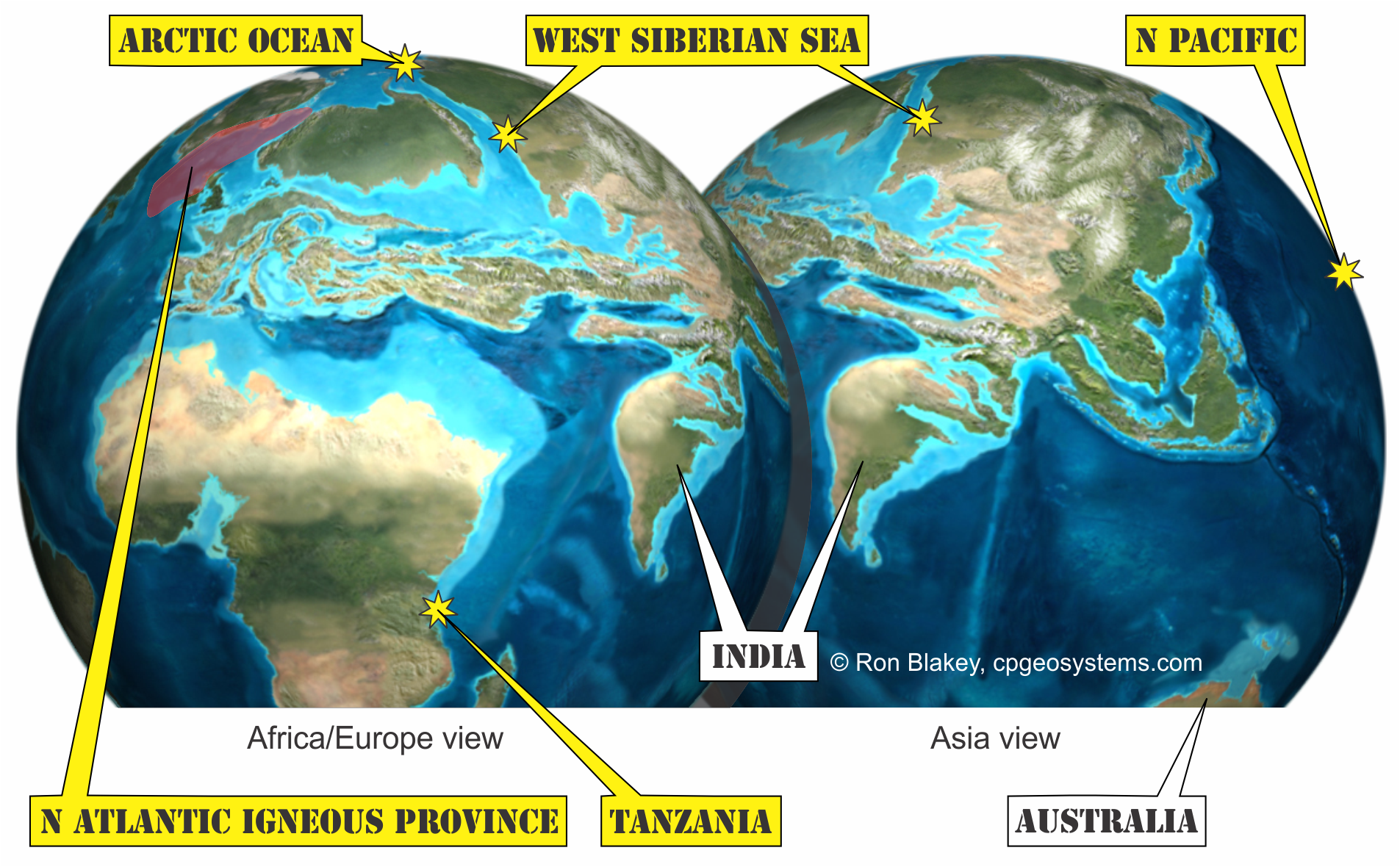The Perplexing PETM
Posted on 23 September 2014 by howardlee
The Paleocene-Eocene Thermal Maximum (PETM) around 56 million years ago is perhaps the most studied of the many episodes of global warming in the geological record, but it still has plenty of puzzles. Professor Daniela Schmidt has written an article in "Geology" highlighting a couple of them, which is an excuse to delve a little into this episode of climate change that has some similarities to, and some important differences from, modern climate change.

A different world 50 million years ago: Eocene globe with locations discussed in this post highlighted in yellow. Paleogeography globes © Ron Blakey, cpgeosystems.com
Rapid change and environmental turmoil
At the onset of the PETM, oceans acidified in less than 10,000 years (a geological blink) by around 0.3pH units as average surface ocean temperatures across the planet rose by 4° to 5°C (7-9°F), with the subsurface oceans warming by 5-6°C (9-11°F). Ecosystems across the world were plunged into turmoil, with poleward migrations, decline of reefs, extinctions of some sea-bottom-living creatures, and in some places 20% of land plants went extinct while plant diversity dropped by more than a third. In mammals the effects included strong natural selection for small body size, and high species turnover, though there was no vertebrate mass extinction. Globally the resulting climate of the early Eocene was up to 15°C (27°F) warmer than today, supporting lush vegetation on Antarctica and the Arctic.
Comparable carbon emissions
This all happened because of a geologically-rapid release of 2,000 to 6,000 Gt of carbon to the atmosphere, compared to modern emissions that could to reach close to 2000GtC by the end of the century if business-as-usual emissions continue (but our emissions are at least 10 times faster than the PETM emissions). The initial cause of the PETM is still debated but there is increasing evidence to link it with gargantuan volcanic eruptions at that time in the North Atlantic (from Norway to Canada) accompanied by methane and CO2 liberated by the underground baking of organic-rich sediments by magma. If confirmed, this would add the PETM to the list of strong warming events linked to the same class of mega-eruption known to geologists as “Large Igneous Provinces” or LIPs for short.
Global Warming
The latest papers confirm the global nature of the PETM warming by highlighting its effects in tropical climes (Tanzania), and a mid-latitude location (near Omsk in Western Siberia), adding to the many locations where this phenomenon has been detected across the globe.
The Tanzanian data show that shallow ocean water reached temperatures around 34-36°C (93-97°F) during the PETM, compared to today’s values at the same location of around 28-29°C (82-84°F). Those PETM temperatures were recalculated by Schmidt to take into account the latest information on global ocean acidification during the PETM, and represent a rise of about 3°C (5.4°F) from already-warm pre-event temperatures. Such high temperatures were beyond the tolerance of tropical plankton species, an echo of the much more extreme End-Permian global warming that gave rise to lethally hot temperatures in the tropics. Tropical marine zooplankton migrated to higher latitudes to survive the PETM.
At that time Western Siberia was a shallow sea connecting the Arctic Ocean to the archipelago that made up Europe and Iran before the Himalayas and the Alps were formed. This location also saw pronounced warming in the PETM, with sea surface temperatures rising by a much larger 7°C (13°F) from their already balmy ~21°C (70°F). The West Siberian Sea laid down a layer of black, oily mud containing traces of green sulfur bacteria, evidence of warm, oxygen-starved waters during the PETM.

Lush life in the Arctic during the Eocene, 50 million years ago (original art - Stephen C. Quinn, The American Museum of Natural History, N.Y.C)
Puzzles
The Tanzanian data suggest there was a time lag of tens of thousands of years between the beginning of the event and the disappearance of plankton populations. That time lag is a puzzle that:
“contradicts everything we know about ecosystem response to decadal temperature variability,” says Schmidt.
The authors themselves note that the sediments in this 5 meter lag interval may have been “reworked” – in other words it looks like the PETM signal may have been jumbled and smeared over a longer interval by sedimentary processes. Elsewhere the PETM’s effect on marine life is rapid and coincident with the onset of the event, for example in Tunisia, Spitzbergen, South America, or the North Pacific.
The Siberian data show that sea surface temperatures were the same in the Arctic Ocean as a mid-latitude sea at 58°N, some 3,000 km (2,000 miles) further south. Fossil plants and animals show us the Arctic didn't freeze even in winter! Other studies show the high-latitude south was also bizarrely warm. It’s hard for climate models to reproduce this lack of temperature gradient between high latitudes and the equator – they tend to simulate high-latitude sea surface temperatures much cooler than the proxy temperature records tell us they were. This implies processes were at work to amplify the polar warming during the Eocene that models do not yet capture. In other words, for the Eocene at least, models appear significantly to downplay warming at high latitudes. One possible explanation may be radically different ocean currents due to the different continental configuration back then.
Timing matters
It has been hard to narrow down the duration of the initial carbon emissions. One paper last fall suggested that the onset of the PETM occurred in as little as 13 years, based on seemingly annually-layered clays in New Jersey. Those authors concluded the PETM was likely caused by a comet exploding in the atmosphere, and was too fast to be a useful analog for modern global warming. But that paper’s conclusions were demolished in a series of responses, which pointed out that the heat capacity of the oceans required centuries to warm to the PETM extent, that an instant release of carbon in the atmosphere would produce a carbon isotopic shift far larger than observed, and that microfossils ruled out the sedimentary rates claimed.
Currently the PETM emissions are estimated to have been spread over between 1,000 and 6,000 years, based on their effects on ocean chemistry and the carbon isotope excursion.
Rapid climate change and its long legacy
PETM data from across the Northern Hemisphere show a sustained ~900,000 year period of elevated sea surface temperatures. Penman et al, who authored the PETM ocean acidification paper mentioned above, find this is consistent with:
“a large, rapid initial pulse of carbon, followed by slower gradual release of carbon perhaps as a feedback to the initial release.”
Those feedback emissions that boosted and sustained the warming may have come from marine clathrates, peat and/or permafrost, modulated by Earth’s orbital wobbles. Alternatively, Penman et al suggest that multiple pulses of carbon emissions separated by a few tens of thousands of years could also explain the data. But the feedback scenario reinforces scientists’ anxiety about a comparable “carbon bomb” being triggered by today’s climate change through the irreversible destabilization of marine clathrates and/or permafrost thawing.
Proxy data and calculations based on ocean chemistry show that levels of CO2 in the atmosphere roughly doubled in the PETM - about the same as we are in the process of doing, but we are doing it at least 10 times faster! Long-term climate sensitivity calculations, which include some permafrost and clathrate feedbacks, suggest a similarly long legacy of human-caused climate change, with temperatures rising by a PETM-like 5°C in 3,000 years then gradually reducing over 23,000–165,000 years! But the PETM emissions time frame (many millennia) looks like it gave most species enough time to adapt, avoiding the ecosystem collapses and mass extinctions the world experienced with more extreme (and more rapid?) emissions associated with the End-Permian, End-Triassic, and other catastrophic times.
Worryingly for us, our emissions are far more rapid than the PETM, and look to be closer to the rates that led to the Permian and Triassic extinctions.
Thanks to Andy Skuce and Glenn Tamblyn for helpful comments































 Arguments
Arguments






























Wright and Shaller reply to Stassen, Zeebe, Pearson in doi/10.1073/pnas.1321876111
Some of their retorts: that Zeebe's ocean model is inappropriate for shallow shelves, that drilling contamination is unlikely for various reasons, and that Stassen's argument assumes deeper water than was present at the site during the subject period. There is more, of course. I am personaly not yet convinced either way, but i eagerly anticipate more work.
sidd
Timing and dating uncertaintly are a constant theme here. The apparently annually-layered ("varve") deposits reported on by Wright and Schaller are just the sorts of detailed record that should - eventually - resolve the controversy. Dating and correlation have constantly been improving in precision, but we are still dealing with vast timescales. My unscientific hunch is that the section reported by Wright and Schaller may turn out to be a short-lived blip within a much broader signal (like a fractal pattern - wiggles within wiggles). But you are right - more papers are sure to come on the PETM.